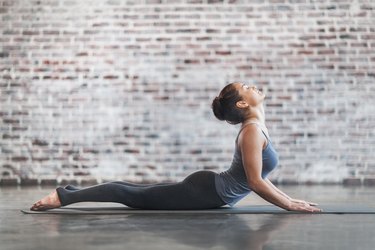
After a tough day at the gym, having some upper or lower back muscle soreness is normal. However, having chronic back pain after exercising can make it difficult for you to maintain a regular workout routine and stay in shape.
Rule Out and Prevent Injury
Video of the Day
Muscle soreness in your back after a workout may be normal, especially if you were targeting your back muscles or trying a new activity that engages your core. That said, you can help prevent strains and overuse injuries that may cause pain by doing a warm-up and cooldown before and after each workout.
Video of the Day
You can also help reduce your risk of injury by increasing the intensity of your workout slowly over time. Lifting too much weight or pushing beyond your ability may cause injury.
Be sure to also use fitness equipment properly in a safe environment. For example, if you have back pain from bench pressing, double-check that your body is positioned correctly on the bench.
However, if you regularly experience upper or lower back pain after a workout, it may be a sign of a more serious condition. In that case, avoid exercises that hurt your back and see your doctor. According to the Mayo Clinic, some possible causes of back pain include:
- Muscle and ligament strains
- Bulging or ruptured discs
- Arthritis
- Osteoporosis
Warning
If back pain comes on suddenly, does not improve or includes sharp pains, this may be a sign of a more serious condition or injury. Stop exercising and consult your doctor.
How to Relieve Back Pain After Working Out
Back soreness after exercise is no fun, but there are ways you can find some relief. For example, incorporating some back stretches into your post-workout routine can help release tension.
1. Stretch and Strengthen
Relieve back pain after a workout by doing some forward and backward stretches, according to the University of Michigan's University Health Service.
For example, to stretch backward, start by standing straight and placing your hands on your lower back. Keeping your knees straight, bend backward from your waist, and then return to the starting position. Be sure not to stretch too far back and stop if you feel any pain.
Then, try a forward stretch: Lie on your back with your knees bent and feet flat on the ground. Bring both knees up to your chest, one at a time, and hug your knees into your chest. You should feel the stretch in your lower back. Then, return to the starting position. You can repeat these stretches throughout the day to relieve back pain.
Exercises and Stretches for Upper, Middle and Low Back Pain
Upper/Mid Back Pain: Some of the most common causes of upper and mid back pain are strains and poor posture, according to the Cleveland Clinic. Once you've consulted your doctor about the root cause of your back pain, you can speak with a physical therapist about trying these upper and mid back stretches to find relief.
Lower Back Pain: A weak core and back are one of the top reasons you may experience low back pain. Try these core- and back-strengthening exercises to help take some of the pressure off your lower back.
2. Other Treatment Options
Applying heat or ice for up to 20 minutes per session to the painful muscles may help lessen the pain. During the first two days after the onset of pain, use only cold on the area. Do not apply heat, according to the University of Michigan's Health Service. After the 48 hours, use heat or ice based on what feels best for your body.
If back pain or soreness is severe, consider taking a few days off from your normal workout routine. Maintain good posture throughout the day and consider taking over-the-counter pain relievers. Sleeping on your side with your knees curled up toward your chest and a pillow between your legs may also help release muscle stiffness and decrease pain, per the Mayo Clinic.
In more severe cases, consider additional therapies. For example, your doctor may recommend sessions with a physical therapist to correct your body position and strengthen muscles. Chiropractic adjustments or acupuncture treatments may also decrease your discomfort, according to the National Institute of Neurological Disorders and Stroke.
What You Can Do to Prevent Back Pain in the Future
1. Stretch Before Exercise
Whether you're working out first thing in the morning or in the afternoon, doing some back stretches and a warm-up can help relieve tension and prep your muscles and joints for movement.
2. Strengthen Your Core and Back
Back pain after exercise can stem from not activating your core in your workout. Make sure you're properly engaging your core during exercise. Core bracing helps protect your back, especially during heavy lifts.
Add back and core strengthening exercises to your workout routine. Strengthening these muscles can help your back feel more supported while exercising.
For example, try the opposite arm and leg lift: Start on your hands and knees. Keeping your back flat and core engaged, slowly raise your right arm and your left leg until they are in a straight line with your back. Hold for five seconds, then lower to the original position and repeat on the other side.
3. Do a Cooldown Post-Workout
You might be tempted to skip a cooldown, especially if you're rushing out the door after a workout. But prioritizing a cooldown can help ease back stiffness and pain, as well as reduce your risk of injury, according to the American Council on Exercise.
Try this 3-minute stretch routine after your workout.